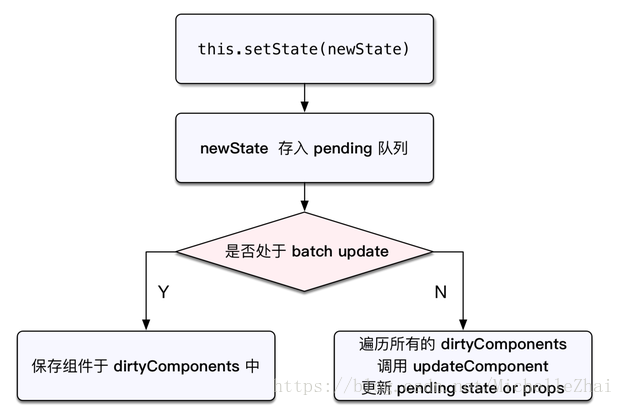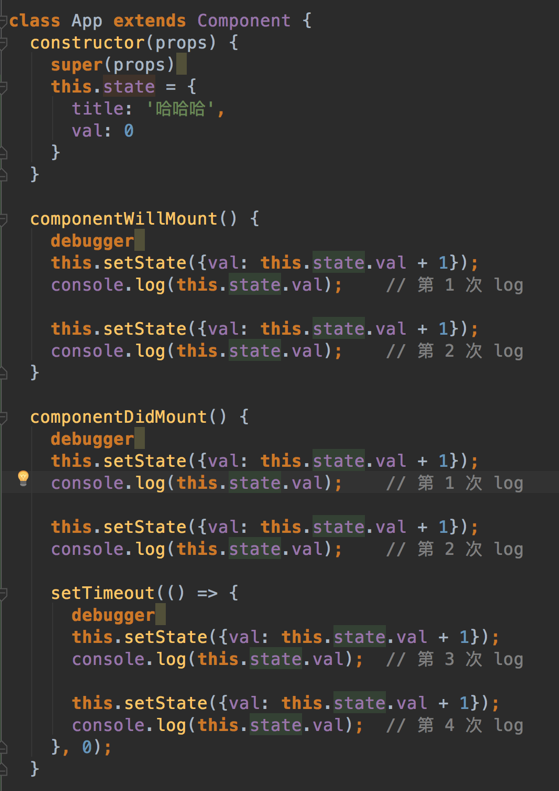转自:https://www.cnblogs.com/mengff/p/9611614.html
1. setState基本特点
1. setState是同步执行的
setState是同步执行的,但是state并不一定会同步更新
2. setState在React生命周期和合成事件中批量覆盖执行
在React的生命周期钩子和合成事件中,多次执行setState,会批量执行
具体表现为,多次同步执行的setState,会进行合并,类似于Object.assign,相同的key,后面的会覆盖前面的
当遇到多个setState调用时候,会提取单次传递setState的对象,把他们合并在一起形成一个新的
单一对象,并用这个单一的对象去做setState的事情,就像Object.assign的对象合并,后一个
key值会覆盖前面的key值
const a = {name : 'kong', age : '17'}
const b = {name : 'fang', sex : 'men'}
Object.assign({}, a, b);
//{name : 'fang', age : '17', sex : 'men'}
name被后面的覆盖了,但是age和sex都起作用了
例如:
class Hello extends React.Component {
constructor(){
super();
this.state = {
name: 'aa'
}
}
componentWillMount(){
this.setState({
name: 'aa' + 1
});
console.log(this.state.name); //aa
this.setState({
name: 'aa' + 1
});
console.log(this.state.name); //aa
}
render() {
return <div>
<div>Hello {this.props.name}</div>
<div>Hello {this.state.name}</div>
</div>;
}
}
ReactDOM.render(
<Hello name="World" />,
document.getElementById('container')
);
componentWillMount中两个log均为初始状态aa,而render中的state.name则为aa2
componentWillMount中的setState均执行了,但是state的更新是延迟的,所以log出的state均为aa
而render中的state.name则在state更新之后,而且只有第二次的aa1起了作用
3. setState在原生事件,setTimeout,setInterval,Promise等异步操作中,state会同步更新
异步操作中setState,即使在React的钩子或合成事件中,state都不会批量更新,而是会同步更新,
多次连续操作setState,每次都会re-render,state会同步更新
2. setState的形式
setState(object,[callback]) //对象式,object为nextState setState(function,[callback]) //函数式,function为(prevState,props) => stateChange
[callback]则为state更新之后的回调,此时state已经完成更新,可以取到更新后的state
[callback]是在setState之后,更准确来说是当正式执行batchUpdate队列的state更新完成后就会执行,不是在re-rendered之后
使用两种形式的setState,state的更新都是异步的,但是多次连续使用函数式的setState,
React本身会进行一个递归传递调用,将上一次函数执行后的state传给下一个函数,因此每次执行
setState后能读取到更新后的state值。
如果对象式和函数式的setState混合使用,则对象式的会覆盖前面无论函数式还是对象式的任何setState,
但是不会影响后面的setState。
例如:
function increment(state,props){
return {count: state.count + 1};
}
function incrementMultiple(){
this.setState(increment);
this.setState(increment);
this.setState({count: this.state.count + 1});
this.setState(increment);
}
上面三个函数式的setState中间插入一个对象式的setState,则最后的结果是2,而不是4,
因为对象式的setState将前面的任何形式的setState覆盖了,但是后面的setState依然起作用
3. setState的基本过程
setState的调用会引起React的更新生命周期的4个函数执行。
shouldComponentUpdate
componentWillUpdate
render
componentDidUpdate
当shouldComponentUpdate执行时,返回true,进行下一步,this.state没有被更新
返回false,停止,更新this.state
当componentWillUpdate被调用时,this.state也没有被更新
直到render被调用时候,this.state才被更新。
总之,直到下一次render函数调用(或者下一次shouldComponentUpdate返回false时)才能得到更新后的this.state
因此获取更新后的状态可以有3种方法:
1. setState函数式
2. setState在setTimeout,Promise等异步中执行
setStatePromise(updator) {
return new Promise(((resolve, reject) => {
this.setState(updator, resolve);
}));
}
componentWillMount() {
this.setStatePromise(({ num }) => ({
num: num + 1,
})).then(() => {
console.log(this.state.num);
});
}
或者
function setStateAsync(nextState){
return new Promise(resolve => {
this.setState(nextState, resolve);
});
}
async func() {
...
await this.setStateAsync({count: this.state.count + 1});
await this.setStateAsync({count: this.state.count + 1});
}
3. setState callback
setState({
index: 1
}}, function(){
console.log(this.state.index);
})
4. componentDidUpdate
componentDidUpdate(){
console.log(this.state.index);
}
4. setState批量更新的过程
在React的生命周期和合成事件执行前后都有相应的钩子,分别是pre钩子和post钩子,pre钩子会调用batchedUpdate方法将isBatchingUpdates变量置为true,开启批量更新,而post钩子会将isBatchingUpdates置为false
如下图所示:

isBatchingUpdates变量置为true,则会走批量更新分支,setState的更新会被存入队列中,待同步代码执行完后,再执行队列中的state更新。
而在原生事件和异步操作中,不会执行pre钩子,或者生命周期的中的异步操作之前执行了pre钩子,但是pos钩子也在异步操作之前执行完了,isBatchingUpdates必定为false,也就不会进行批量更新。
5. setState的缺点
1. setState有可能循环调用
调用setState之后,shouldComponentUpdate、componentWillUpdate、render、componentDidUpdate 等生命周期函数会依次被调用(如果shouldComponentUpdate没有返回 false的话),如果我们在render、componentWillUpdate或componentDidUpdate中调用了setState方法,那么可能会造成循环调用,最终导致浏览器内存占满后崩溃
2、setState可能会引发不必要的渲染
可能造成不必要渲染的因素如下:
(1)新 state 和之前的一样。这种情况可以通过 shouldComponentUpdate 解决。
(2)state 中的某些属性和视图没有关系(譬如事件、timer ID等),这些属性改变不影响视图的显示。
3、setState并不总能有效地管理组件中的所有状态
因为组件中的某些属性是和视图没有关系的,当组件变得复杂的时候可能会出现各种各样的状态需要管理,这时候用setState管理所有状态是不可取的。state中本应该只保存与渲染有关的状态,而与渲染无关的状态尽量不放在state中管理,可以直接保存为组件实例的属性,这样在属性改变的时候,不会触发渲染,避免浪费
6. setState和replaceState的区别
setState是修改其中的部分状态,相当于Object.assign,只是覆盖,不会减少原来的状态
replaceState是完全替换原来的状态,相当于赋值,将原来的state替换为另一个对象,如果新状态属性减少,那么state中就没有这个状态了
7. 一个实例分析

上图的执行结果为 0 0 1 1 3 4
参考: http://www.360doc.com/content/17/0803/18/27576111_676420051.shtml
https://blog.csdn.net/kongjunchao159/article/details/72626637
https://blog.csdn.net/michellezhai/article/details/80098211
https://www.cnblogs.com/danceonbeat/p/6993674.html
https://segmentfault.com/a/1190000010682761
https://segmentfault.com/a/1190000015821018
